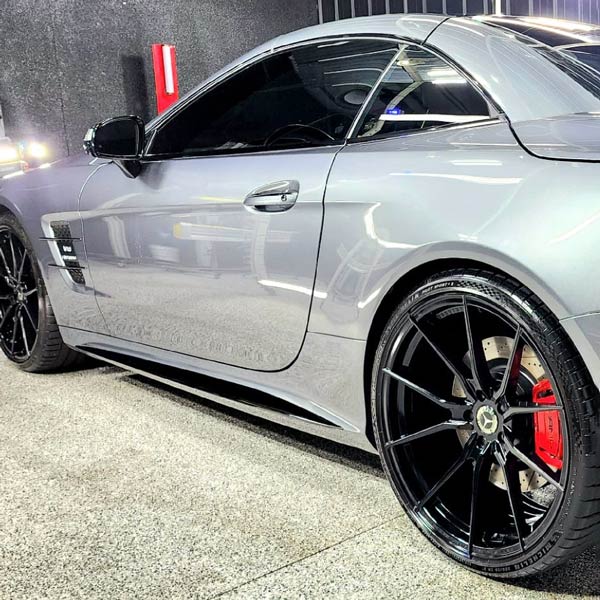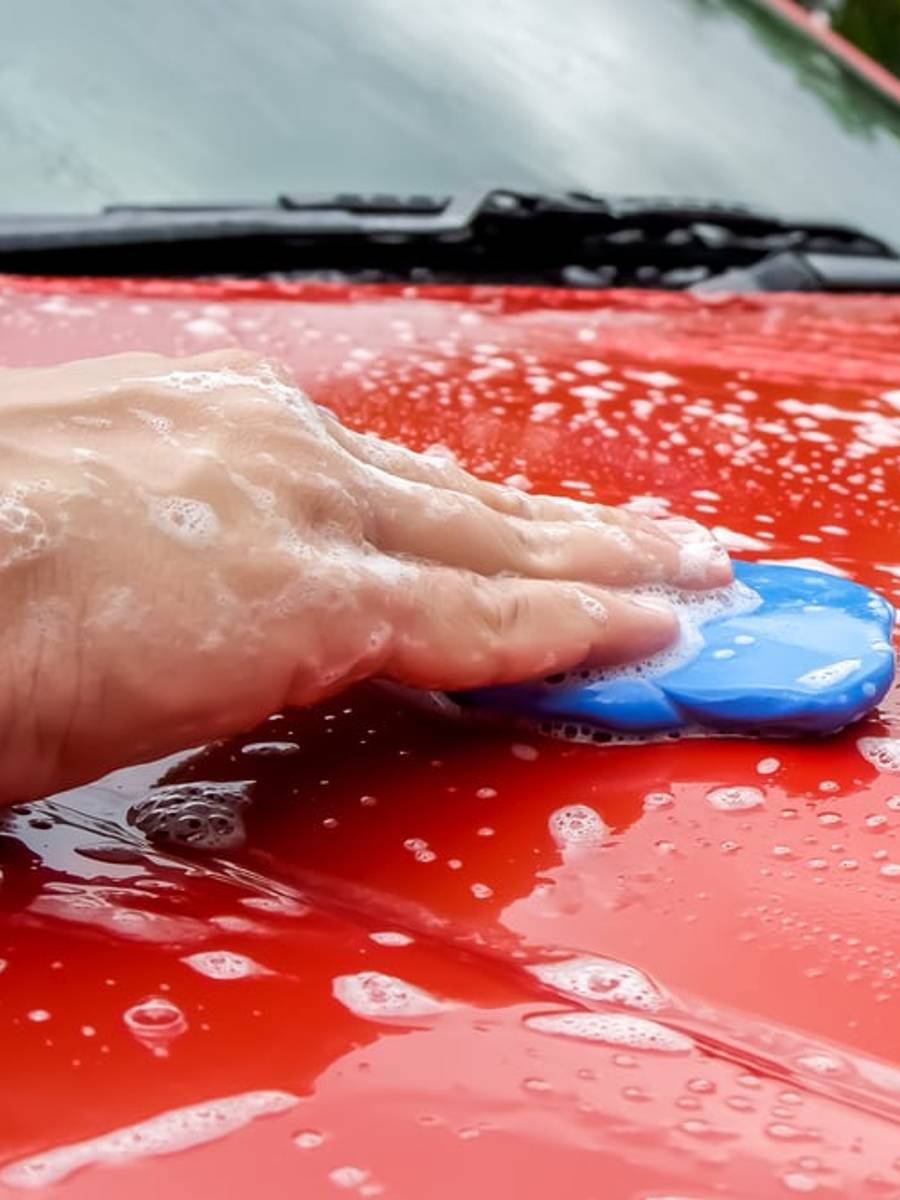How Ceramic Finish Protects Your Auto's Paint and Keeps It Looking New
Ceramic layer has become a noticeable service for auto paint security, supplying a robust defense versus a variety of ecological hazards. By creating a semi-permanent bond with the lorry's surface, it successfully secures microscopic flaws and gives a shield against oxidation, dust, and UV damages. This not only protects the visual allure of the vehicle however additionally simplifies maintenance routines. Yet, the ins and outs of just how this technology works and its benefits over traditional techniques call for a closer exam, revealing compelling factors to consider this cutting-edge strategy for your vehicle.
What Is Ceramic Finish?
Ceramic finish is often considered as an advanced development in automotive paint protection. ceramic coating. This innovative item is a liquid polymer that chemically bonds with the vehicle's manufacturing facility paint, creating a protective layer that enhances durability and visual charm. Unlike traditional wax or sealers, which supply only short-term protection, ceramic layers use lasting outcomes, commonly covering numerous years with appropriate maintenance
The key elements of ceramic coatings are silicon dioxide (SiO2) and titanium dioxide (TiO2), which add to their hydrophobic homes. This hydrophobic nature allows water to grain and roll off the surface, properly avoiding impurities like dirt, crud, and bird droppings from adhering to the paint. Cars treated with ceramic layers require much less frequent washing and are less complicated to maintain.
Furthermore, ceramic coatings supply UV defense, which helps stop oxidation and fading of the paint due to sun direct exposure. This facet not only preserves the auto's aesthetic charm yet also adds to its resale worth with time. In general, ceramic finishes stand for a significant leap ahead in the world of auto treatment, supplying a robust solution for car proprietors looking for to maintain their financial investment.
How Ceramic Finish Functions
Ceramic coating consists of a liquid polymer that chemically bonds with the factory paint of a car (ceramic coating). The main part of ceramic coverings is silica dioxide (SiO ₂), which supplies premium firmness and durability against scrapes, UV rays, and other exterior pollutants.
When applied properly, the covering permeates the microscopic pores of the paint surface, creating a semi-permanent bond. This causes a smooth, glossy finish that boosts the automobile's visual appeal while simultaneously fending off water, dirt, and crud. The hydrophobic nature of the layer makes sure that pollutants slide off conveniently, minimizing the frequency of washing and the chance of scratches during cleansing.

Advantages of Ceramic Layer
The application of ceramic coating offers numerous advantages that significantly enhance the protection and look of a lorry's paint. Among the key advantages is its capability to produce a robust, hydrophobic layer that fends off water, dirt, and various other impurities. why not try this out This property not just maintains the surface cleaner for longer periods yet also makes washing the vehicle simpler and much less labor-intensive.
In addition, ceramic layers give premium defense versus dangerous UV rays, which can cause oxidation and fading gradually. ceramic coating. This anchor UV resistance aids preserve the original color and gloss of the automobile's paint, thereby protecting its visual allure for years
Furthermore, ceramic coatings are chemically resistant, providing defense versus acidic pollutants such as bird droppings, tree sap, and road crud. This resistance helps prevent etching and discoloration, which can compromise the stability of the paint.
Last but not least, the sturdiness of ceramic layers extends beyond standard waxes and sealers, frequently long-term numerous years with correct maintenance. This lasting defense inevitably translates right into cost financial savings, as automobile proprietors can lower the frequency of reapplication and upkeep efforts. On the whole, ceramic layers stand for a significant investment in automobile care.
Contrasting Ceramic Finish to Standard Techniques
Usually ignored in the mission for ideal car defense, the contrast between ceramic layer and conventional approaches such as shaving and sealers exposes considerable differences in longevity, efficiency, and upkeep. Standard waxes normally offer a short-lived protective layer, usually lasting just a few weeks to a couple of months, while sealers can expand this period to several months. In comparison, ceramic layers supply a robust, lasting shield that can withstand for a number of years when correctly used.
In terms of performance, ceramic finishings display exceptional hydrophobic buildings, properly driving away water and pollutants, which stops dirt and gunk from sticking to the surface. This residential or commercial property not only improves the lorry's look but additionally streamlines the cleansing process. Traditional waxes and sealants, while they may use some water resistance, do not match the level of defense supplied by ceramic coatings.
The upkeep program for both options deviates considerably. While standard techniques require constant reapplication and upkeep, ceramic coverings are made to endure the roughness of day-to-day driving with marginal intervention, making them a much more reliable selection for vehicle enthusiasts seeking lasting protection. Inevitably, the choice additional reading between ceramic finishing and standard techniques depends upon the wanted level of protection and maintenance commitment.
Upkeep Tips for Ceramic Coated Cars
Preserving a ceramic covered car requires a tactical strategy to make certain the long life of the protective layer. Firstly, normal cleaning is essential. Use a pH-neutral shampoo and microfiber wash mitts to avoid scraping the finish while successfully removing dirt and pollutants. Objective to clean your automobile every 2 weeks, or more frequently in harsh problems.
Additionally, prevent automated auto cleans that use brushes, as these can endanger the stability of the ceramic layer. Instead, select a touchless wash or a hand laundry. After cleaning, drying is crucial; utilize a premium microfiber towel to stop water areas.
Using a ceramic-specific upkeep spray can improve the finishing's hydrophobic buildings and add an additional layer of security. This must be done periodically, depending upon your driving conditions.

Verdict
To conclude, ceramic coating functions as an effective safety step for auto paint, providing a durable obstacle against ecological damage and improving the car's aesthetic appeal. Its distinct residential or commercial properties, consisting of hydrophobicity and UV security, contribute to durable shine and tidiness. Contrasted to conventional techniques, ceramic layers existing premium performance and durability, eventually lowering maintenance initiatives. Adopting ceramic finishing modern technology can dramatically prolong the life-span of an automobile's outside, ensuring it remains visually attractive and well-protected.